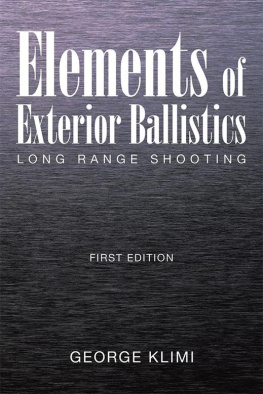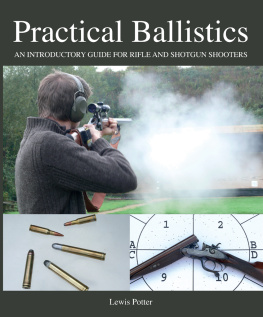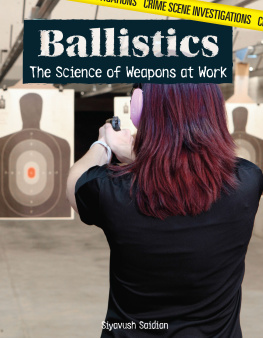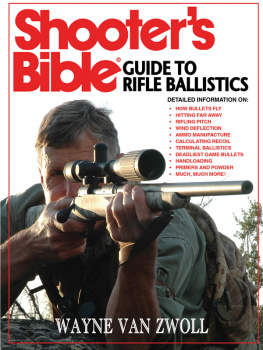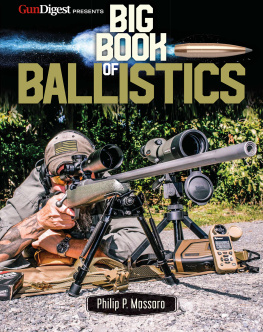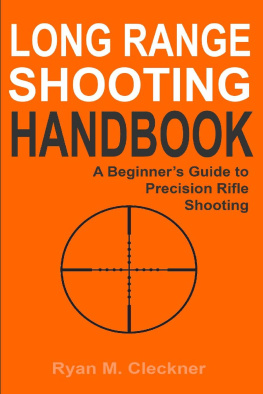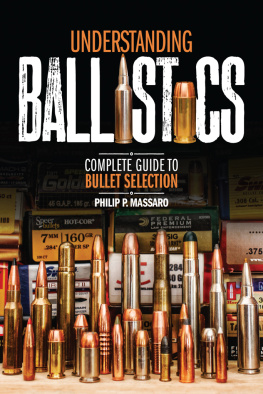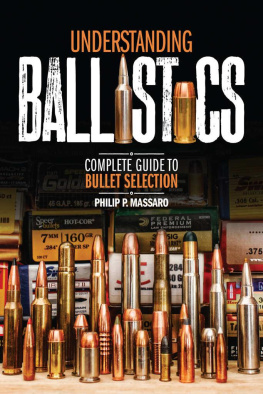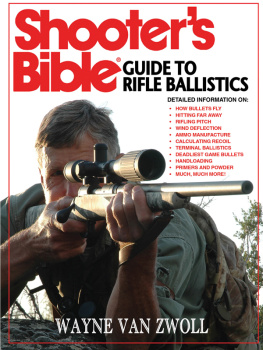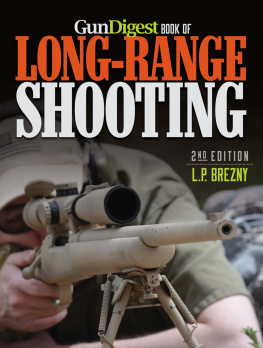Elements of
Exterior Ballistics LONG RANGE SHOOTING
FIRST EDITION GEORGE KLIMI Copyright 2016 by George Klimi.
| Library of Congress Control Number: | 2016902024 |
| ISBN: | Hardcover | 978-1-5144-5767-2 |
| Softcover | 978-1-5144-5766-5 |
| eBook | 978-1-5144-5765-8 |
All rights reserved. No part of this book may be reproduced or transmitted in any form or by any means, electronic or mechanical, including photocopying, recording, or by any information storage and retrieval system, without permission in writing from the copyright owner. Any people depicted in stock imagery provided by Thinkstock are models, and such images are being used for illustrative purposes only. Certain stock imagery Thinkstock. date: 03/07/2016 Xlibris 1-888-795-4274 www.Xlibris.com 730788 Contents Chapter 1
A Brief Approach to Aiming with Small Arms Chapter 2
Long Range Inclined Shooting Chapter 3
Standard Atmosphere in Exterior Ballistics Chapter 4
Elementary Exterior Ballistics Chapter 5
Differential Equations of Exterior Ballistics To My Special Son Iven To My Son Erio and to My Wife Dorina George Klimi (Gjergj Klimi), Ph.D., is a retired associate professor of Mathematics who taught Math at NYC College of Technology and at Pace University (New York). date: 03/07/2016 Xlibris 1-888-795-4274 www.Xlibris.com 730788 Contents Chapter 1
A Brief Approach to Aiming with Small Arms Chapter 2
Long Range Inclined Shooting Chapter 3
Standard Atmosphere in Exterior Ballistics Chapter 4
Elementary Exterior Ballistics Chapter 5
Differential Equations of Exterior Ballistics To My Special Son Iven To My Son Erio and to My Wife Dorina George Klimi (Gjergj Klimi), Ph.D., is a retired associate professor of Mathematics who taught Math at NYC College of Technology and at Pace University (New York).
George is the author of four books on exterior ballistics: Exterior Ballistics with Applications (2008), Exterior Ballistics of Small Arms (2009), Exterior Ballistics: A New Approach (2010), Exterior Ballistics: The Remarkable Methods (2014) The third edition of Exterior Ballistics with Applications, Xlibris, is published in December 2011. George Klimi, from 1970 until 1993, has been professor of Physics & Mathematics and chair of Physics Department at the Military Academy of Tirana, Albania. In 90s George used to work at the Committee of Science and Technology, and at the Ministry of Higher Education and Research in Albania as Director of TEMPUS Office, responsible for the implementation of the European Community Programs to restructure the higher education. He was awarded the Gold Medal of Eagle, by the President of Republic of Albania, for his contribution in the democratic movement against dictatorship, and for restructuring the higher education in Albania. My heartfelt gratitude is owed to my friend and colleague Col. Genc Kokoshi, ex-professor at the Academy of General Staff, Tirana, for the ingenious work in designing the PC programs related with my exterior ballistics books.
There are three main Exterior Ballistics PC programs associated with the book. The PC programs (codes), in quick basic (QB), were compiled in 1991 by Col. Genc Kokoshi. They are modified, time after time by the author, to reflect the advancements in Exterior Ballistics. The core of all PC programs that are developed since 2005 are the codes that Col. Kokoshi has rigorously designed in 1991.
The three initial PC programs were based on Siaccis G-function and were valid only for a type of artillery projectile, when field cannon shooting is done in TSA atmosphere. The QB codes designed by Col. Kokoshi are fascinating compact codes that made possible for me to advance in the study of exterior ballistics. Elements of Exterior Ballistics: Long Range Shooting is a concise but comprehensive instructive book on exterior ballistics applied into long range shooting with small arms. The foundations of the book are innovatively related to the exterior ballistics of point-mass projectile as well as to the new findings and contemporary ballistics methods presented in my preceding books. The book is designed for exterior ballistics professionals, amateurs, and competitive shooters interested in long range shooting and, in general, in exterior ballistics.
Though the exterior ballistics applications are related to long range shooting with small arms, the reader can easily extend the ballistics techniques to the artillery fire. Physicists, mathematicians and engineers have a lot of interesting applied topics that are not present in traditional physics and engineering textbooks. A good knowledge in Calculus and Physics is necessary to fully understand and make use of the special techniques the exterior ballistics uses to predict the projectile trajectory. The readers with a good background in Pre-calculus have no difficulty to comprehend the topics exposed in the first four chapters of the book. In addition, the large number of examples, in each topic, demonstrates the exterior ballistics solving techniques and helps the reader to understand the ballistics concepts and principles, as well as the challenging theoretical and practical applications. The PC programs associated with the book are a great tool to the study of exterior ballistics, to predict the projectile trajectory and aim the firearm to the center of the target.
Each topic is methodically and rigorously presented to avoid ambiguity that is present in the contemporary exterior ballistics, especially in non-mathematical or non-technical presentation of exterior ballistics. George Klimi, PhD New York, January 2016 , Elements of Exterior Ballistics: Long Range Shooting, (EEB), consists of five chapters. The first two chapters deal exclusively with horizontal long range shooting as well as with mountain and inclined shooting. Knowledge in algebra and trigonometry is necessary for the marksman to understand and apply the techniques of inclined shooting and of zeroing in the firearm at the target. In chapter two, there is introduced the non-rigidity principle that is a beautiful, simple, and thrilling technique applied in practice of long range and inclined shootings. We introduce the Non-Rigidity-Principle that can be used to find the super elevation or super depression angle and to set up the aiming angle in uphill or downhill shooting.
The non-rigidity principle was been used in quite all my books without mentioning it. At the end of the second chapter are included many interesting exercises that are solved with the use of PC programs. The reader can use the PC programs also to verify the accuracy of different methods that we have used to predict the projectile trajectory. The PC programs include as well the techniques to predict the effect of range-wind and cross-wind. The prediction method of wind effects are based on the Didions approach that uses the relative motion and relative velocity of a projectile in presence of range wind or cross-wind. In other words, to study the wind effect there is considered an observer that moves with the velocity of range-wind, or with velocity of cross-wind.
The third chapter provides a review of standard atmospheres and the techniques used to calculate the characteristics of atmosphere at shooting sites. The forth chapter, Elementary Exterior Ballistics, includes elementary equations that describe the projectile trajectory in standard and non standard atmosphere. Though the elementary trajectory equations (third order parabola, modified exponential equation) are approximate, the prediction accuracy of the elements of the ballistics trajectory we obtain employing those equations is remarkable. In this chapter are presented approximate techniques to estimate the Coriolis Effect and cross-wind drift, as well as some methods that allow the long range shooter to measure, in practice of shooting, the wind drift, the spin drift, and the Coriolis Effect. The remarkable Newton-Snells law and Tangent Law on similar trajectories (included in chapter four) are some simple techniques to predict accurately the elements of bullet trajectory in a non-standard atmosphere when we know the standard firing range tables. Particularly, those two laws give the possibility to the shooter to easily calculate the departure angle, as well as the aiming angle to zero in the rifle in non standard atmosphere when we know the range table in standard atmosphere, and vice versa.
Next page
